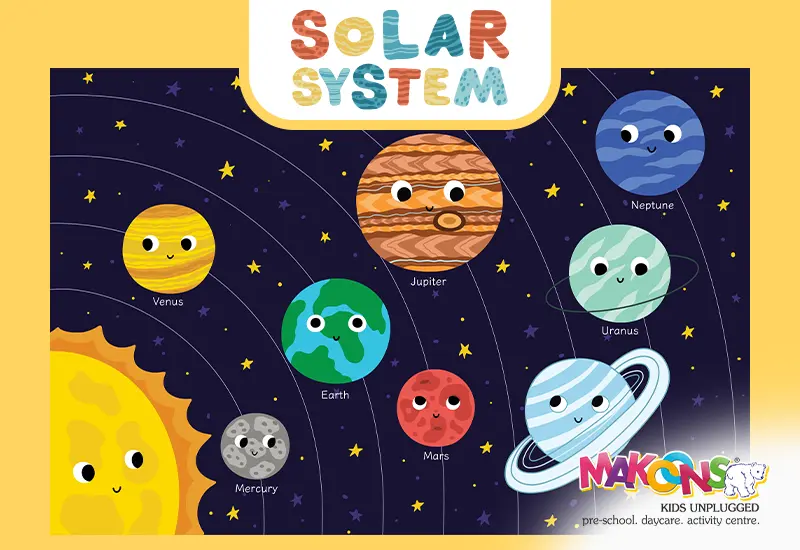Hello, space explorers! Are you all set for an awesome adventure into our solar system? Let’s take off and explore some great planet facts for kids from Best preschool in India that will make learning about our space community absolutely thrilling!
Our Solar System: A Cosmic Family
Our solar system is a large family with the Sun as the father and eight planets as the children, all dwelling together in space. Every planet has its very own character and unique characteristics that make it one-of-a-kind. When we study planets, we find out how wonderful our home in space actually is!
Explore Solar System Names For Kids-
Mercury: The Speedy Messenger
First, there’s Mercury, the Sun’s closest planet. Could you believe being this close to something so hot? Mercury is the smallest planet in our solar system, a chunk larger than our Moon. Because it’s so near the sun, it zooms around it really, really fast! A 12 months on Mercury is simply 88 Earth days. That’s a lot shorter than our year!.
FUN FACT: The sun is a lot bigger compared to what we see from earth, Standing on Mercury we can differentiate!
Venus: The Hot and Cloudy World
Venus and Earth are very identical as their sizes are quite alike. They are also referred to as “sibling planet”.Venus is a whole different world. It’s extremely hot, hotter than an oven! The atmosphere on Venus is filled with clouds that hold heat, so it’s the hottest planet in our solar system.
FUN FACT: Venus rotates in reverse direction as compared to other planets! So, on Venus, the sun could upward thrust in the west and set within the east. How first rate is that?
Earth: Our Wonderful Home
And here we are! Earth is our wonderful home planet, the only one we know of in the whole universe that has life on it. Isn’t that wonderful? Earth is special because it contains lots of liquid water, which is necessary for life as we know it. It has quite a good atmosphere which provides us with good air to stay alive.
FUN FACT: Earth’ name is quite different from other planet! Its name was derived from an old English and German term that simply means “ground.”Also it is quite old around 4.54 billion years old.
Mars: The Red Planet
Next up on our cosmic road trip? The one and only Mars! You know, that planet with the cool rusty red vibes that earned it the nickname ‘Red Planet’. Mars is very intriguing to scientists and has sent robotic rovers to investigate the surface of the planet. They hope to find evidence of past or existing life.
FUN FACT: Did you know that if you could jump on Mars, you’d soar nearly three times higher than you can on Earth? That’s because Mars has much weaker gravity!
Jupiter: The Giant King
Now the first gas giant i.e. Jupiter, it has a very huge size that all planets can fit inside without squeezing. Jupiter is made up of the same gases as the sun , mainly hydrogen and helium.
FUN FACT: Jupiter spins so incredibly fast that a single day on this giant planet is less than 10 Earth hours long! Talk about a speedy day
Saturn: The Ringed Beauty
If you are thinking about planets for children, Saturn’s gorgeous rings are likely to be one of the first things that pop into your head. Saturn’s rings are not solid; they consist of billions of fragments of ice, rock, and dust, all orbiting the planet. Saturn is yet another gas giant, comprised primarily of hydrogen and helium. It is not as large as Jupiter but its rings distinguish it and are a highlight when we study about planets.
FUN FACT:Saturn is so exceptionally light for its huge size that if you could discover a tub large sufficient, it might certainly float.
Uranus: The Sideways Planet
Let’s go even farther out to Uranus. As the huge Uranus rotates on its facet, It is quite captivating to look! Picture a spinning top that’s tilted over – that’s sort of the way Uranus rotates. This side-to-side tilt results in very extreme seasons. Uranus is also much colder than Saturn and Jupiter.
FUN FACT: how fascinating! Uranus’s moons are named Titania, Oberon, and Miranda, which are picked from William Shakespeare’s dramas and Alexander Pope’s poetry.
Neptune: The Windy Blue World
Lastly, we come to Neptune, the most distant planet from the Sun. It’s another ice giant and is famous for its powerful winds – the fastest in our solar system! Neptune is a lovely blue color, just like Uranus, also because of the gases present in its atmosphere. Studying planets like Neptune teaches us just how big and diverse our solar system is.
FUN FACT: Neptune’s winds are seriously intense – they may be three times stronger than Jupiter’s and 9 times more potent than the strongest winds on earth!
Conclusion
So, there you have it! A quick tour of our amazing solar system and some fun facts about planets. Each & every planet has its own uniqueness and is very attractive in its very own way. Keep exploring and learning about the wonders of space – there’s always something new to discover! Learning about planets is just the beginning of an incredible adventure
Also Read blog to teach you kids about Animals that live on land and water Both

